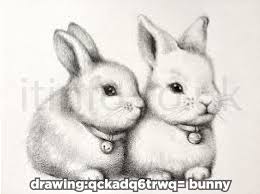Drawing:qckadq6trwq= Bunny represents a unique and captivating style in the art world, characterized by its charming and whimsical portrayal of bunnies. This particular drawing has gained attention for its distinctive approach and has become a favorite among art enthusiasts. The drawing= Bunny stands out due to its playful and detailed depiction, which often highlights the delicate features and expressive qualities of the bunny.
Understanding the significance of Drawing:qckadq6trwq= Bunny can enhance your appreciation of this art form. It’s not just about the visuals; it’s about the emotion and creativity that come alive through the artwork. Whether you are an artist or a fan, delving into the intricacies of this drawing can provide valuable insights and inspire your own artistic journey.
Table of Contents
Understanding the Art Style and Technique
Drawing:qckadq6trwq= Bunny falls under a particular art style that blends realism with a touch of fantasy. This style often involves a mix of detailed line work and soft shading to bring the bunny to life. Artists might use various techniques to achieve the desired look, including layering colors and textures to create depth and realism.
Key techniques used in creating the bunny drawing include sketching, shading, and detailing. Artists usually start with a rough sketch to outline the bunny’s shape and position. They then gradually add details, such as fur texture and facial expressions, to enhance the drawing’s lifelike quality. Common materials used in this process include graphite pencils, colored pencils, and fine liners.
Step-by-Step Guide to Creating Your Own Drawing:qckadq6trwq= Bunny
Before you start Drawing:qckadq6trwq= Bunny, it’s essential to prepare and plan. Begin by choosing a clear reference image of a bunny to guide your drawing. This image will help you understand the proportions and details that make the bunny unique. Sketch a basic outline lightly on your paper to establish the bunny’s position and size.
Planning your drawing also involves deciding on the materials you’ll use, such as pencils, erasers, and paper types. The choice of materials can affect the final look of your drawing, so select those that best suit your artistic style and the level of detail you want to achieve.
Drawing the Outline
Once you have your reference image and materials ready, start drawing the outline of the bunny. Focus on getting the proportions right by measuring and comparing different parts of the bunny’s body. Use light, smooth strokes to create the outline, as this will make it easier to adjust and refine as you proceed.
Adding Details and Textures
With the outline complete, begin adding details and textures to your drawing. Pay attention to the bunny’s fur pattern, whiskers, and facial features. Use various shading techniques to create the illusion of texture and depth. Adding details will bring your drawing to life and make it more realistic.
Finalizing and Shading
In the final stage, focus on shading and refining your Drawing:qckadq6trwq= Bunny. Apply shading gradually to avoid harsh lines and create a smooth transition between light and dark areas. Use blending tools or your fingers to soften the shading and give your bunny a natural look. Finalize by erasing any unnecessary lines and adding highlights to enhance the drawing’s overall appearance.
Common Mistakes to Avoid in Drawing:qckadq6trwq= Bunny
When Drawing:qckadq6trwq= Bunny, several common mistakes can hinder the quality of your artwork. One frequent issue is getting the proportions wrong, which can make the bunny appear unnatural or awkward. Ensure that the size and position of each body part are accurate to maintain a balanced look.
Another common mistake is neglecting the details. Overlooking small features, such as the texture of the fur or the expression in the bunny’s eyes, can result in a less engaging drawing. Pay close attention to these elements to enhance the realism and appeal of your artwork.
Popular Variations of Drawing:qckadq6trwq= Bunny
Drawing:qckadq6trwq= Bunny come in various styles and interpretations, each with its unique characteristics. Some popular variations include realistic bunnies that closely resemble real-life rabbits, and cartoonish bunnies with exaggerated features and vibrant colors. Each style offers a different way to capture the essence of a bunny, appealing to various artistic tastes.
These variations often reflect the artist’s personal style or the intended message of the artwork. For example, a cartoon bunny might be used to convey a playful or humorous theme, while a realistic bunny may aim to showcase the beauty and detail of the animal.
Showcasing and Sharing Your Drawing:qckadq6trwq= Bunny
Drawing:qckadq6trwq= Bunny Once you’ve completed your Drawing:qckadq6trwq= Bunny, showcasing and sharing it can help you gain feedback and connect with other artists. Present your artwork professionally by framing it or displaying it in a digital portfolio. Consider sharing your drawing on social media platforms or art communities to reach a broader audience.
Drawing:qckadq6trwq= Bunny with other artists and art enthusiasts can provide valuable feedback and encouragement. Participate in online forums or local art groups to discuss your work and learn from others. This interaction can help you improve your skills and gain recognition in the art world.
Conclusion
Drawing:qckadq6trwq= Bunny In conclusion, creating and perfecting a Drawing:qckadq6trwq= Bunny involves understanding the art style, mastering techniques, and avoiding common mistakes. By following the steps outlined in this guide, you can enhance your drawing skills and produce captivating bunny artworks.
For further learning, explore additional resources such as art books, online tutorials, and workshops. Continuously practicing and experimenting with different techniques will help you refine your skills and discover your unique artistic voice.
Read More: Punchmade Dev Net Worth







